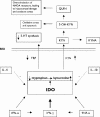The role of indoleamine 2,3-dioxygenase (IDO) in the pathophysiology of interferon-alpha-induced depression
- PMID: 14719046
- PMCID: PMC305266
The role of indoleamine 2,3-dioxygenase (IDO) in the pathophysiology of interferon-alpha-induced depression
Abstract
The mechanisms by which administration of interferon-alpha induces neuropsychiatric side effects, such as depressive symptoms and changes in cognitive function, are not clear as yet. Direct influence on serotonergic neurotransmission may contribute to these side effects. In addition, the enzyme indoleamine 2,3-dioxygenase (IDO), which converts tryptophan into kynurenine, may play an important role, first, because IDO activation leads to reduced levels of tryptophan, the precursor of serotonin (5-HT), and thus to reduced central 5-HT synthesis. Second, kynurenine metabolites such as 3-hydroxy-kynurenine (3-OH-KYN) and quinolinic acid (QUIN) have toxic effects on brain function. 3-OH-KYN is able to produce oxidative stress by increasing the production of reactive oxygen species (ROS), and QUIN may produce overstimulation of hippocampal N-methyl-D-aspartate (NMDA) receptors, which leads to apoptosis and hippocampal atrophy. Both ROS overproduction and hippocampal atrophy caused by NMDA overstimulation have been associated with depression.
Les mécanismes par lesquels l'administration d'interféron alpha provoque des effets secondaires neuropsychiatriques comme des symptômes de dépression et des changements de la fonction cognitive ne sont pas encore clairs. L'influence directe sur la neurotransmission sérotoninergique peut contribuer à ces effets secondaires. La 2,3-dioxygénase (IDO), enzyme qui convertit le tryptophane en cynurénine, peut en outre jouer un rôle important tout d'abord parce que l'activation de l'IDO entraÎne une réduction des concentrations de tryptophane, précurseur de la sérotonine (5-HT) et, par conséquent, une baisse de la synthèse centrale de 5-HT. De plus, des métabolites de la cynurénine, comme la 3-hydroxy-cynurénine (3-OH-KYN) et l'acide quinolinique (QUIN), ont des effets toxiques sur la fonction cérébrale. La 3-OH-KYN peut produire un stress oxydatif en élevant la production d'espèces réagissant à l'oxygène (ERO) et la QUIN peut produire une surstimulation des récepteurs de la N-méthyl-D-aspartate (NMDA) de l'hippocampe, qui entraÎne l'apoptose cellulaire et une atrophie de l'hippocampe. La surproduction d'ERO et l'atrophie de l'hippocampe causée par la surstimulation de la NMDA ont toutes deux été associées à la dépression.
Figures

References
-
- Bonaccorso S, Marino V, Biondi M, Grimaldi F, Ippoliti F, Maes M. Depression induced by treatment with interferon- alpha in patients affected by hepatitis C virus. J Affect Disord 2002; 72(3):237-41. - PubMed
-
- Maes M. Evidence for an immune response in major depression: a review and hypothesis. Prog Neuropsychopharmacol Biol Psychiatry 1995;19(1):11-38. - PubMed
-
- Collier J, Chapman R. Combination therapy with interferon- alpha and ribavirin for hepatitis C: practical treatment issues. BioDrugs 2001;15(4):225-38. - PubMed
-
- Juengling FD, Ebert D, Gut O, Engelbrecht MA, Rasenack J, Nitzsche EU, et al. Prefrontal cortical hypometabolism during low-dose interferon alpha treatment. Psychopharmacology (Berl) 2000; 152(4):383-9. - PubMed
-
- Pavol MA, Meyers CA, Rexer JL, Valentine AD, Mattis PJ, Talpaz M. Pattern of neurobehavioral deficits associated with interferon alfa therapy for leukemia. Neurology 1995;45(5):947-50. - PubMed
MeSH terms
Substances
LinkOut - more resources
Full Text Sources
Other Literature Sources
Medical
Research Materials
